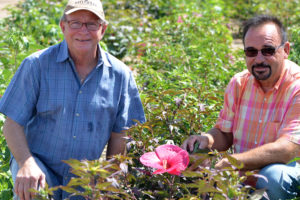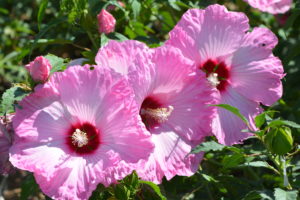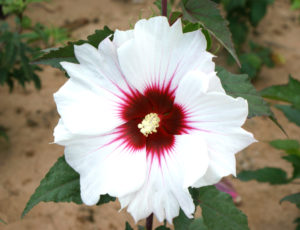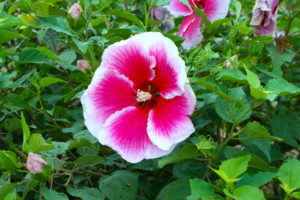J. Berry claims two major awards with Texas A&M AgriLife hibiscus hybrids
Writer: Kay Ledbetter, 806-677-5608, [email protected]
Contact: Dr. Dariusz Malinowski, 940-552-9941, [email protected]
VERNON – Dr. Dariusz Malinowski and Jim Berry have discussed commercialization potential of winter-hardy hibiscus hybrids every August for a number of years.

This year Malinowski, a Texas A&M AgriLife Research plant physiologist at Vernon, and Berry, president of J. Berry in Grand Saline, are celebrating their joint success after picking up a third major award for the J. Berry Summer Spice Hibiscus Collection.
The Summer Spice Hibiscus Collection introduced by J. Berry in the spring features cultivars developed by Malinowski. They are: Amaretto, coral-salmon; Ambrosia, fuchsia with white eye; Bleu Brulee, sky blue; Brandy Bleu, blue; Cordon Bleu, blue; Crème de la Crème, white with serrated petal edges; Crepe Suzette; bright pink; Grape Sorbet, purple; and Plum Flambe, light plum.
“These new, never seen before flower colors immediately grabbed the attention of the ornamental industry,” Malinowski said.
Shortly after trial sales started at select Lowe’s and Calloway’s stores in Texas in early summer, the Summer Spice Hibiscus collection won the 2018 Greenhouse Grower Magazine Editor’s Medal of Excellence and Readers’ Medal of Excellence at the Cultivate’ 18 Conference in Ohio.

“These awards bestowed upon our Summer Spice Hardy Hibiscus Collection are a validation of our innovation, and the importance of collaboration between academia and commercial horticulture production,” Berry said.
Malinowski, whose primary research focuses on developing cool-season forage grasses for semi-arid environments of the Southern Great Plains, initiated the hibiscus breeding project in 2008 in collaboration with coworkers Steve Brown, former director of Texas Foundation Seed Service, and Dr. Bill Pinchak, AgriLife Research animal nutritionist.

Their creations caught the eye of Texas A&M AgriLife administration, and Malinowski expanded the project into a full research project in 2010. Within the last eight years, the team has evaluated over 17,000 winter-hardy hibiscus hybrids and by 2017 they had disclosed to the Texas A&M University System’s Commercialization Office over 280 unique lines.
“J. Berry has been the most involved commercial partner in designing our new winter-hardy hibiscuses,” Malinowski said. “Our collaboration started right from the beginning and recently resulted in a sponsored research grant from J. Berry to breed new winter-hardy hibiscus hybrids with particular traits.”

Berry said their sponsorship of this focused breeding program “is our opportunity to continue to lead the market in introducing superior plants that bring value and solutions for growers and homeowners.”
Malinowski smiled as he remembered his first creations and their beautiful, never-seen flowers growing on 7-foot-tall plants. After those initial plants, he said, his breeding philosophy has constantly evolved “as we adopted suggestions of our commercial partners.
“Initially, I was interested in developing novel flower colors and shapes, but I was not particularly concerned about plant size and shape,” he said.

However, the requirements of his commercial partners resulted in additional efforts to breed small, compact plants that better fit small gardens and patios, Malinowski said.
“For our industry, naturally compact growth habits translate to less labor required at the nursery level, greater freight efficiency and minimal to zero use of growth regulators,” Berry said. “For our customers, these superior genetics provide highly rewarding, low-maintenance beauty. Residential landscapes are getting smaller as the homes get larger. The Summer Spice Hibiscus are perfect for smaller garden areas.”
Malinowski’s breakthrough introduction of Blue Angel, the first winter-hardy hibiscus with the illusive bluish flower color in 2012, was followed by about 15 additional hybrids with improved blue flower color and size.
“Initially, the blue hybrids inherited a trait of small flower size from one of the parental species,” he said. “When we tried to increase the flower size, the color was diluted to pinkish or purplish tones.”

However, Malinowski said he has just developed a couple of hybrids with almost a dinner-plate size flower and a nice, blue color.
“Our breeding strategy is based on creating maximum genetic variation allowing for new gene recombination,” he said. “By hybridizing several winter-hardy hibiscus species and combining their genes in one hybrid, we have broken the stereotype of white, pink and red flower color in winter-hardy hibiscus and created novel flower colors and shapes never seen in this species before.”
After a few years of selective breeding, Malinowski said they now have winter-hardy hibiscus hybrids with blue, magenta, plum, salmon, gray, silver, almost black, and of course, numerous shades of reds and pinks. Particularly interesting, he said, are the dual or even multiple colored flowers that often closely resemble flowers of distant tropical relatives.
“Orange and yellow are even more impossible than the blue color to introduce to this species using traditional breeding techniques,” Malinowski said. “I still remember the look on my friends’ and peers’ faces when I came up with the idea of creating a blue hibiscus about 10 years ago.
“When I decided to create a winter-hardy version of the tropical hibiscus cultivar ‘Cindy’s Heart,’ one of my favorite flowers, my friends just shook their heads in disbelief again. We now have a winter-hardy hibiscus hybrid that looks almost identical to Cindy’s Heart, and are evaluating it for commercial release.”
Malinowski said the program’s success would not be possible without close collaboration among AgriLife Research, other Texas A&M University System entities and J. Berry in developing formal agreements leading to the commercialization of the winter-hardy hibiscuses.
“The new phase of collaboration should bring even more breathtaking winter-hardy hibiscus cultivars on the market,” he said. “In the next few years, we are going to combine the novel flower colors with dark foliage and a compact plant size.”
Doing this is not as simple as hybridizing a hibiscus plant with blue flowers with a plant with dark leaves, Malinowski said.
“The blue color, for example, is very difficult to transfer to the next generation,” he said. “We have learned, though, how it can be done. This year, we got the first hybrid with sky-blue flowers that resemble a tropical hibiscus flower on a plant with purplish foliage. It may not be the perfect product yet, but it is another breakthrough in winter-hardy hibiscus breeding.”
Berry said he looks forward to what’s to come from this collaboration.
“The existing Summer Spice cultivars are ground-breaking, and this breeding program will continue to transform the market for the benefit of growers, retailers and gardeners,” Berry said. “We value our collaboration with Texas A&M and pride ourselves on our reputation of introducing and promoting superior plants to the industry.”





